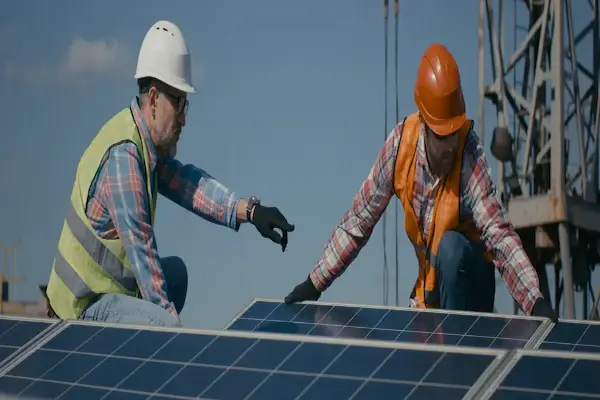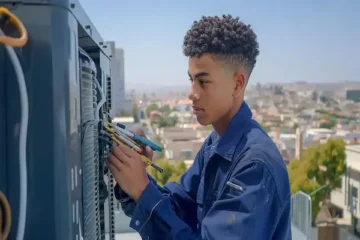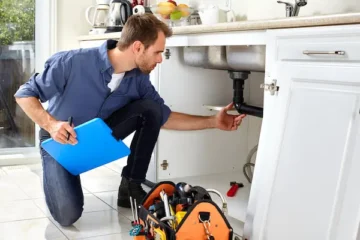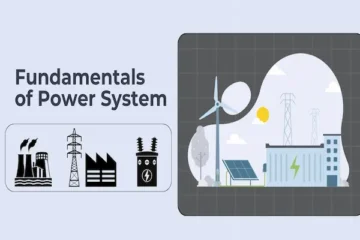Solar Energy (PV fundamentals)
Free online solar installer training: learn design, safety, and electrical engineering.
Anúncios
Prepare for certifications and jobs in 2025.
Complete Career Launch Programs for 2025
Solar energy jobs are growing fast, and many companies need trained installers.
You can learn solar installation skills online for free through programs offered by organizations like Solar Energy International, GRID Alternatives, and various training academies.
These courses teach you the basics without costing money upfront.
Free online solar training covers important topics like system design, safety rules, and electrical work.
You learn how solar panels work and how to install them safely.
Many programs also help you prepare for industry certifications that employers want to see.
The best part is that these courses fit your schedule.
You can study at home and go at your own pace.
Some programs even offer job placement help after you finish the training.
Key Takeaways
- Free online solar installer training programs are available from multiple organizations and provide comprehensive education without upfront costs.
- These courses cover essential skills like system design, safety protocols, and electrical work needed for solar installation jobs.
- Many programs offer flexible scheduling and career support including certification preparation and job placement assistance.
What Is Free Solar Installer Training Online?
Free solar installer training online gives you the skills to install solar panels without paying for expensive classes.
These programs teach basic electrical work, safety rules, and how solar systems work through your computer or phone.
Overview of Online Solar Training Programs
Online solar training programs are web-based courses that teach you how to install solar panels.
You can take these classes from home using a computer or tablet.
Many programs offer free certification when you finish the course.
Some popular options include Solar Energy International (SEI) and SkillCat training.
Installation Basics Training 200 is a 200-hour program that takes five weeks to complete.
It focuses on skills that solar companies want to hire.
The courses cover topics like:
- Solar panel basics
- Electrical safety
- System design
- Installation methods
You get access to videos, reading materials, and practice tests.
Some programs also include live webinars where you can ask questions.
Key Features and Benefits
Free solar energy training offers several important benefits for new installers.
You save money compared to paid programs that can cost thousands of dollars.
Flexible scheduling lets you learn at your own pace.
You can study after work or on weekends without missing your current job.
Most programs provide:
- Digital certificates upon completion
- Access to industry experts
- Updated course materials
- Practice exercises and quizzes
The training prepares you for NABCEP certification, which many employers require. This credential shows you understand solar installation safety and best practices.
You also learn about local building codes and permits. This knowledge helps you work legally in your area.
Types of Training Available
Solar installation courses come in different formats to match your learning style and goals. Basic courses teach fundamental concepts like how solar panels create electricity.
Intermediate programs focus on hands-on installation skills. These cover wiring, mounting systems, and connecting inverters safely.
Webinar-based training offers live sessions where instructors demonstrate techniques. You can ask questions and get real-time answers.
Some key course types include:
- 40-hour installer certification programs
- Safety and electrical basics
- System design workshops
- Commercial installation training
Advanced courses cover battery storage systems and grid-tie connections. These help you work on more complex projects.
Specialty training focuses on specific areas like rooftop installations or ground-mounted systems. You can choose courses that match the type of work you want to do.

Key Components and Systems in Solar Installation
Solar systems have three main parts that work together to turn sunlight into usable power. Solar panels capture the sun’s energy, inverters change the power type, and batteries store extra energy for later use.
Solar Panels and Photovoltaic Technology
Solar panels are the most visible part of any solar system. They contain photovoltaic cells that turn sunlight directly into electricity.
Most panels use silicon cells arranged in a grid pattern. When sunlight hits these cells, electrons move and create electric current.
You’ll find three main types of solar panels:
- Monocrystalline: Most efficient but costs more
- Polycrystalline: Good balance of cost and performance
- Thin-film: Cheapest but takes more space
Panel power is measured in watts. Home systems typically use panels between 250-400 watts each.
Weather affects how well panels work. They produce less power on cloudy days and none at night. Cold temperatures actually help panels work better than hot weather.
Panels need proper angling toward the sun to work best. In the US, south-facing panels at a 30-45 degree tilt usually produce the most power.
Role of Inverters and Charge Controllers
Inverters change the DC power from solar panels into AC power that homes use. Without an inverter, you can’t power normal household items.
There are three inverter types:
- String inverters: Connect multiple panels together
- Power optimizers: Work with string inverters but optimize each panel
- Microinverters: Attach to each panel separately
String inverters cost less but if one panel has problems, it affects the whole string. Microinverters cost more but each panel works independently.
Solar charge controllers protect batteries from getting too much power. They stop batteries from overcharging, which can damage them.
You need charge controllers in off-grid systems or any system with battery storage. PWM controllers are cheaper, while MPPT controllers are more efficient but cost more.
The controller size must match your solar array and battery bank. Too small and it won’t handle the power. Too big wastes money.
Energy Storage and Battery Integration
Batteries let you store solar power for use when the sun isn’t shining. This makes your system work at night or during power outages.
Lithium-ion batteries are most popular now. They last longer and charge faster than older lead-acid types. They also take up less space.
Battery capacity is measured in kilowatt-hours (kWh). Most homes need 10-20 kWh of storage for basic needs during outages.
Grid-tied systems with batteries need special inverters called hybrid inverters. These can send power to your home, charge batteries, and feed extra power back to the grid.
Battery systems need monitoring equipment to track charge levels and performance. Smart systems can automatically decide when to use stored power versus grid power to save money.
Proper wiring connects all components safely. DC disconnects let you shut off power for maintenance. AC disconnects do the same for the house connection.
Core Skills and Knowledge Covered in Online Courses
Free online solar training programs focus on three main skill areas that prepare you for real-world solar installation work. These courses teach you how to physically install solar panels, connect electrical systems safely, and follow industry safety rules.
Solar Panel Installation Techniques
You will learn how to mount solar panels on different roof types including asphalt shingle, tile, and metal roofs. Online courses teach you how to find the best placement for panels to get maximum sun exposure.
The training covers how to use mounting rails and clamps to secure panels. You practice measuring roof spaces and planning panel layouts. Most courses show you how to handle panels without damaging them.
You learn about different panel types like monocrystalline and polycrystalline. The courses explain how weather affects installation timing. You also study how to work around roof obstacles like vents and chimneys.
Training includes using basic tools like drills, levels, and measuring tape. You learn how to seal roof penetrations to prevent leaks.
Electrical Integration and System Design
Online courses teach you how to wire solar panels together in series and parallel connections. You learn about DC and AC electricity basics that apply to solar power systems.
The training covers how inverters convert DC power from panels into AC power for homes. You study different inverter types including string inverters and microinverters.
You learn how to size electrical components like fuses and breakers. Courses explain how to connect solar systems to the electrical grid safely. You study electrical codes that apply to solar energy installations.
Training includes reading electrical diagrams and using meters to test connections. You learn how battery storage systems work with solar panels.
Safety Standards and Best Practices
You learn OSHA safety rules for working on roofs and with electricity. Online courses teach you how to use safety equipment like harnesses and hard hats properly.
The training covers how to identify electrical hazards during solar installation work. You study proper ladder safety and fall protection methods. Courses explain how to work safely around power lines.
You learn about arc flash protection and lockout procedures. Training includes recognizing unsafe roof conditions that could cause falls or injuries.
The courses teach you how to shut off electrical systems before starting work. You study first aid basics for electrical accidents and falls.
Certifications and Career Pathways
Solar installer jobs require specific certifications that prove your skills to employers. The solar industry offers clear career paths from entry-level positions to advanced roles with higher pay.
Certification Options and Industry Standards
The NABCEP (North American Board of Certified Energy Practitioners) certification is the gold standard in solar installation. This credential shows employers you have proven skills and knowledge.
You can start with the NABCEP Entry Level certificate. This basic certification requires no experience and costs around $300. It covers solar basics and safety rules.
The NABCEP PV Installation Professional certification is the top credential. You need 58 hours of solar installation training and one year of work experience. This certification can increase your pay by $5,000 to $10,000 per year.
OSHA 10 safety training is required by most employers. This course teaches construction safety rules and takes 10 hours to complete.
Some states require electrical licenses for solar work. Check your local rules before starting your career.
Job Prospects for Solar Installers
Solar installer jobs are growing faster than most careers. The Bureau of Labor Statistics expects 63% job growth through 2032.
Entry-level solar installers earn $35,000 to $45,000 per year. Experienced installers make $50,000 to $70,000 annually. Lead installers and supervisors can earn over $80,000.
The clean energy sector offers many job types:
- Residential installer – Works on home solar systems
- Commercial installer – Installs large business systems
- Ground-mount specialist – Builds solar farms
- Maintenance technician – Repairs existing systems
Most solar companies provide on-the-job training. Your renewable energy course completion helps you get hired faster.
Continuing Education Opportunities
Solar technology changes quickly. You need ongoing education to stay current with new equipment and methods.
Many solar installation training programs offer advanced courses. These cover topics like battery storage, smart inverters, and electrical troubleshooting.
Solar Energy International (SEI) provides free webinars and resources. Their courses help you learn new skills without paying high fees.
Professional organizations offer networking and learning opportunities. The Solar Power International conference is the largest industry event.
Some installers advance to sales, design, or project management roles. A solar installation course gives you the foundation for these career moves.
Choosing the Right Free Online Solar Installer Training
Finding quality free training requires careful research of providers, understanding basic requirements, and having the right technology setup. Most programs focus on solar energy fundamentals and renewable energy industry standards.
Reputable Training Providers
Several established organizations offer legitimate free solar installer training programs. Solar Energy International (SEI) provides over 30 years of experience in renewable energy education with expert-led online courses.
GRID Alternatives offers Installation Basics Training 200, a comprehensive 200-hour program spanning five weeks. This training focuses on skills that solar energy employers actively seek.
SkillCat provides certification-focused training with competitive industry connections. Their programs emphasize practical skills needed for solar energy installations.
Goodwill Industries runs hands-on training programs that include job placement support. These programs connect students directly with renewable energy employers.
When choosing a provider, check for NABCEP recognition or industry partnerships. Look for programs that offer both theoretical knowledge and practical application in solar energy systems.
Entry Requirements and Prerequisites
Most free online solar installer training programs have minimal entry requirements. You typically need a high school diploma or equivalent to enroll.
Basic math skills are essential for solar energy calculations. You should be comfortable with simple algebra and geometry concepts.
Some programs require physical fitness assessments since solar installation involves rooftop work. Others may ask for background checks before job placement assistance.
No prior experience in renewable energy is usually required. Most programs start with fundamental concepts and build up to advanced installation techniques.
Age requirements vary by program, but most accept students who are 18 years or older.
Technology and Equipment Needed
You need a reliable computer or tablet with internet access for online coursework. Most programs work on standard web browsers without special software.
Video capabilities are important since many solar energy courses include visual demonstrations and virtual lab sessions. A webcam may be required for live sessions.
Basic tools like calculators help with solar energy system calculations. Some programs provide downloadable apps or online calculators.
For hands-on components, certain programs may ship practice materials or require access to local training facilities. Check if your chosen renewable energy program includes physical equipment or requires you to source materials independently.
Mobile compatibility allows you to study on smartphones during commutes or breaks from work.





